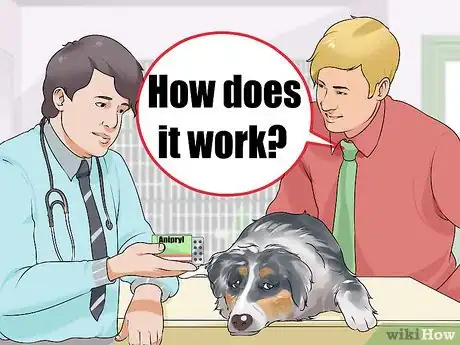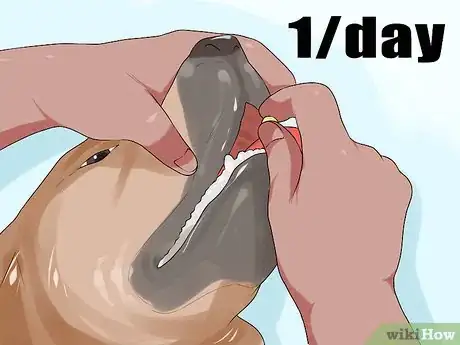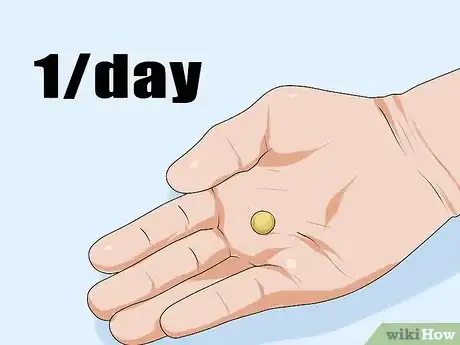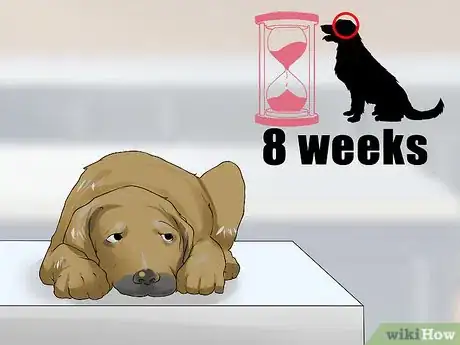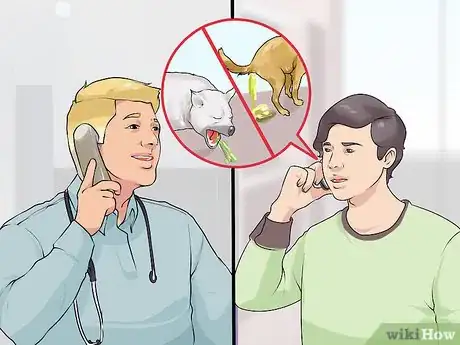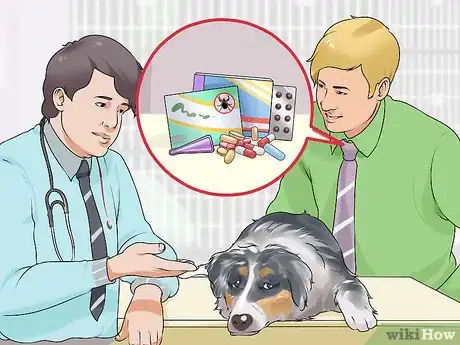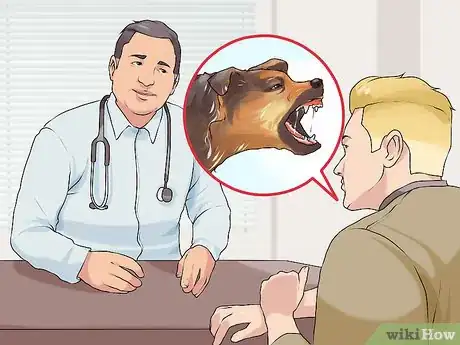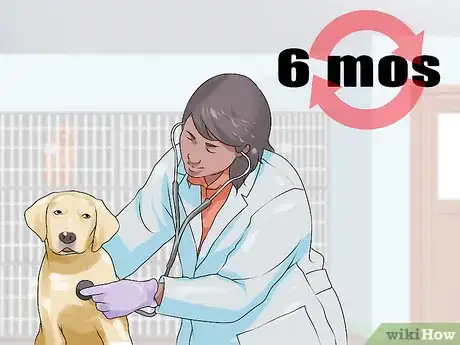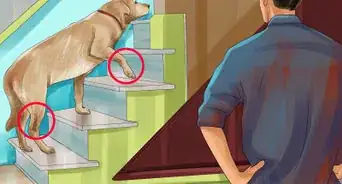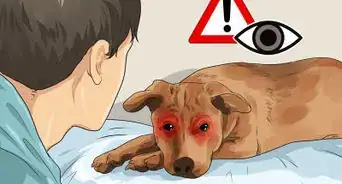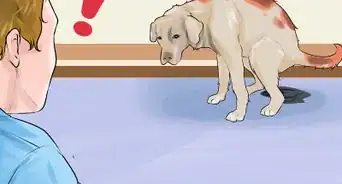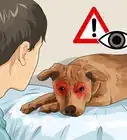This article was co-authored by Pippa Elliott, MRCVS. Dr. Elliott, BVMS, MRCVS is a veterinarian with over 30 years of experience in veterinary surgery and companion animal practice. She graduated from the University of Glasgow in 1987 with a degree in veterinary medicine and surgery. She has worked at the same animal clinic in her hometown for over 20 years.
There are 10 references cited in this article, which can be found at the bottom of the page.
wikiHow marks an article as reader-approved once it receives enough positive feedback. In this case, 88% of readers who voted found the article helpful, earning it our reader-approved status.
This article has been viewed 17,520 times.
Dog dementia is like Alzheimer’s in people. As a dog get older, its brain function can start decreasing, leading to behavioral changes like disorientation, increased howling, and staring blankly into space.[1] Although dog dementia cannot be cured, it can be managed with a medication called Anipryl that helps improve brain function. If your dog has dementia, learn how to give your dog Anipryl and work with your vet to ensure your dog is getting the maximum benefit from the medication.
Steps
Administering Anipryl
-
1Follow prescription instructions carefully. When your vet diagnoses your dog with dementia, they will explain how you can manage this condition. If you decide to treat your dog with Anipryl, you will need to follow your vet’s prescription instructions carefully.[2] Doing so will help your dog get the most benefit from the drug. Ask your vet questions about Anipryl:
- How does it work?
- How do I give it?
- How much does it cost?
- Are there any bad side effects?
- When will my dog start to improve?
- How long will my dog need to be on it?
-
2Give Anipryl once a day by mouth. Anipryl is an oral drug that is available as pills or chewable tablets.[3] It is best to give Anipryl in the morning.[4] Although it's not necessary to give Anipryl with food, you can give your dog its Anipryl dose with its morning meal.[5]Advertisement
-
3Remember to give each dose. Anipryl is a daily medication. If you forget a dose, though, don't panic. Simply give the missed dose once you remember. However, if you don’t remember until it’s nearly time for your dog’s next dose, give only the scheduled dose and skip the missed dose.[8]
- Do not give your dog a double dose of Anipryl. This can lead to an overdose, which can cause serious side effects like seizures and insomnia (inability to sleep).[9]
-
4Wait for symptom improvement. Anipryl works by increasing the amount of dopamine in the brain.[10] Medications that change brain activity can take a long time to have a noticeable effect. For Anipryl, it will probably take four to eight weeks before you see improvement in your dog’s dementia symptoms.[11]
- Contact your vet if your dog’s symptoms do not start improving after about a month. Your vet may double your dog’s current dosage of Anipryl for another month. If there’s still no improvement, your vet may recommend another medication.[12]
-
5Monitor your dog for negative side effects. Your dog may experience some negative side effects while on Anipryl. Contact your vet if your dog doesn’t seem to be doing well on the drug:[13]
- Vomiting
- Diarrhea
- Tiredness
- Decreased appetite
- Wobbliness
Working with Your Vet
-
1Tell your vet about your dog’s medications. Some drugs should not be given with Anipryl. Before you start your dog on Anipryl, give your vet a list of your dog’s current medications, including flea and tick preventatives. Also, tell your vet about any nutritional supplements your dog is taking.[14]
- Examples of nutritional supplements are glucosamine and omega-3 fatty acids.
- Your vet will decide if your dog can safely take Anipryl with its other medications.
- Meperidine, which relieves pain, should not be given with Anipryl.[15]
-
2Let your vet know if your dog has aggression. Anipryl has been shown to increase aggression in dogs with this behavioral problem.[16] Therefore, if your dog has aggression, your vet will recommend against starting your dog on Anipryl.
-
3Visit your vet every six months. While your dog is on Anipryl, your vet will want to see it every six months. During these appointments, your vet will examine your dog and take a blood sample.[17] An examination will allow your vet to notice improvements in your dog’s symptoms.
- Medications can sometimes affect the function of different organs, especially in older dogs. The blood work will indicate if Anipryl is negatively affecting any of your dog’s organs, like its liver or kidneys.
- Based on exam findings and blood work results, your vet may decide to adjust the drug dosage.
Warnings
References
- ↑ http://www.lbah.com/word/canine/cognitive-dysfunction-syndrome-cds/
- ↑ http://www.lbah.com/word/anipryl/
- ↑ http://dogdementia.com/treatment/
- ↑ http://www.1800petmeds.com/Anipryl-prod10335.html?AFFID=MS&ID=288693392&utm_source=bing_ads&utm_medium=cpc
- ↑ https://www.petcarerx.com/anipryl/10175#10325
- ↑ https://vetlabel.com/lib/vet/meds/anipryl/
- ↑ http://www.lbah.com/word/anipryl/
- ↑ http://www.1800petmeds.com/Anipryl-prod10335.html?AFFID=MS&ID=288693392&utm_source=bing_ads&utm_medium=cpc
- ↑ http://www.1800petmeds.com/Anipryl-prod10335.html?AFFID=MS&ID=288693392&utm_source=bing_ads&utm_medium=cpc
- ↑ https://vetlabel.com/lib/vet/meds/anipryl/
- ↑ http://www.srdogs.com/Pages/care.cd.html
- ↑ http://www.veterinarypartner.com/Content.plx?A=2549
- ↑ https://vetlabel.com/lib/vet/meds/anipryl/
- ↑ https://indoorpet.osu.edu/dogs/aging_pets/cds
- ↑ http://www.1800petmeds.com/Anipryl-prod10335.html?AFFID=MS&ID=288693392&utm_source=bing_ads&utm_medium=cpc
- ↑ https://vetlabel.com/lib/vet/meds/anipryl/
- ↑ http://www.lbah.com/word/anipryl/
- ↑ http://www.lbah.com/word/anipryl/
- ↑ http://www.1800petmeds.com/Anipryl-prod10335.html?AFFID=MS&ID=288693392&utm_source=bing_ads&utm_medium=cpc
- ↑ http://www.srdogs.com/Pages/care.cd.html
- ↑ https://vetlabel.com/lib/vet/meds/anipryl/
- ↑ http://www.srdogs.com/Pages/care.cd.html
- ↑ http://www.1800petmeds.com/Anipryl-prod10335.html?AFFID=MS&ID=288693392&utm_source=bing_ads&utm_medium=cpc
About This Article
To treat dog dementia with Anipryl, follow your vet’s prescription carefully. You’ll need to give your dog Anipryl every morning in either pill form or as a chewable tablet. If you use the pills, try hiding them in your dog’s food or in a treat. While you’ll want to remember to give your dog its medication, if you forget a dose simply give it to them as soon as you remember. However, do not give your dog a double dose, which can cause serious health complications. Since it can take 4 to 8 weeks for Anipryl to work, call your vet if you don’t see any improvements after a month. For more tips from our Veterinary co-author, including how to watch your dog for negative side effects from Anipryl, keep reading!
